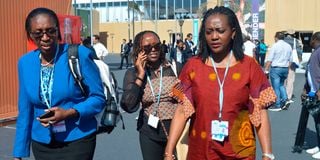Counties get Sh156m climate change cash for four-year period

Environment Cabinet Secretary Soipan Tuya (right) and staff from her ministry at the COP27 conference in Sharm el-Sheikh City, Egypt on November 12, 2022.
In Sharm el-Sheikh, Egypt
Counties that have enacted climate laws and regulations and have dedicated technical personnel in place have started receiving climate change funds to the tune of $1.3 million per year.
Speaking during the launch of the African Green Climate Finance National Designated Authorities Network (AFDAN) in Sharm el-Sheikh, Egypt, on the sidelines of the ongoing United Nations Climate Change Conference (COP27), the network’s coordinator Peter Oluoch said 43 counties have already started receiving and spending the cash.
“Today we have launched what is one of the greatest platforms for Africa which will support all the 54 African countries to mobilise climate finance in a sustainable manner to support locally-led climate adaptation action at the village level,” said Mr Oluoch.
“As you may be aware, Kenya is among the top countries funded by the Green Climate Fund (GCF) with money amounting to $1 billion. Unfortunately, this money does not usually reach local people where loss and damage are really happening, which is why as of today we have changed the setup and now the money will go to the local level,” he added. “The money will be transferred to the Central Bank and then to the counties after which it is taken to the climate change funds.”
Mr Oluoch said the counties receiving the funds have established a dedicated climate change technical person in charge of the money and have committed 2 per cent of their development funds to climate change.
“We are now giving each of these counties $1.3 million per year for four years and more money is coming. This money will directly go to local people with their climate change committees,” he said.
AFDAN was officially unveiled on Monday during a high-level side event that was graced by several dignitaries including Kenya’s Environment Cabinet Secretary Soipan Tuya, who gave the keynote address.
Global emissions
The network, in its official statement, observed that adaptation has accounted for less than 24 per cent of total climate finance flows into the continent. This is despite the fact that African countries contribute less than 4 per cent to global emissions but bear the brunt of their impacts, which is why there is a need for a concerted effort to increase the flow of climate finance to Africa.
“Climate change is impeding Africa’s long-term sustainable development and poses an immediate threat to its people, creating conflict and destroying lives and livelihoods from the shores of Senegal to the Savannah of Kenya. Therefore, countries must join forces to push for bold commitments at global, regional, sub-national, and deep community and sectoral/thematic levels,” AFDAN stated.
AFDAN further explained that the Notre Dame Global Adaptation Index, which summarises a country’s vulnerability to climate change and other global challenges, indicated that 30 of the world’s 40 most climate-vulnerable countries are in Africa.
“There is an urgent developmental challenge with the potential to derail progress toward achieving all Sustainable Development Goals (SDGs) in Africa. From Morocco to Kenya, the poor, and especially women and children, are the hardest hit by the impact of climate change as they rely on natural resources and ecosystems for their livelihoods,” AFDAN noted.
According to the network, various reports indicate that Africa needs approximately $2.8 trillion, or $250 billion each year, between 2020 and 2030 to implement its updated Nationally Determined Contributions (NDCs).
Experts further highlight that the financing gap is significant as all African countries together have a GDP of $2.4 trillion, implying that 10 per cent of the continent’s GDP needs to be mobilised above and beyond current flows every year for the next 10 years.
“This analysis is based on 51 out of 53 African countries that provided data on the costs of implementing their NDCs. Collectively, they represent more than 93 per cent of Africa’s GDP.”
According to the network’s officials, the main objective of the side event was to amplify and raise Africa’s voice on the mobilisation of green finances and encourage increased climate finance flows into and within the continent.




